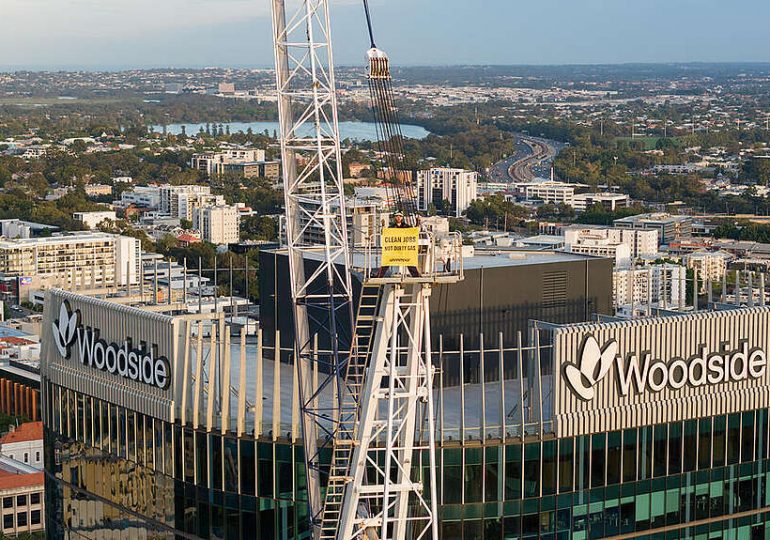Greenpeace Australia activist holds ‘Clean Jobs, Not Dirty Gas’ banner from a crane outside Woodside’s headquarters in Perth.
© Greenpeace
As a Western Australian, I know that WA can be the best and worst of places. Whether you are talking about the weather (the best – except for the heatwaves), the football (the Dockers can be a mixed bag), the media (one statewide newspaper owned by a gas-loving billionaire), or the beaches (hands down the best!), the place can be both infuriating and wondrous.
As we watch the majority of the country broaden the time distance between us (no daylight savings over here), it is easy to feel like WA is the misunderstood and problematic teenager of the Australian family. We love to sulk about it too. The more east coasters complain about WA’s GST allocation, rising greenhouse gas emissions, or Covid-era closed borders, the more our parochialism seems to be confirmed. WA is “unique”! Or so cries our Premier as he justifies WA’s energy transition pathway; in which carbon emissions are set to go up rather than down.
Woodside Energy’s North West Shelf (NWS) gas project on the Burrup Peninsula, Western Australia. © Greenpeace
Change on an industrial scale
A key factor of the unique WA economy is its reliance on gas, largely resulting from its policy of reserving 15% of all exportable gas. While this approach has buffered WA from the surging gas prices seen on the east coast, the flipside is the dependence it creates. When a new gas field is proposed (e.g. Woodside’s Scarborough project), it becomes a magnet for new gas users (e.g. Perdaman’s fertiliser plant), generating more demand for gas and so the cycle continues.
What WA may be missing out on in the process is a chance to be at the forefront of a change that is “every bit as significant as the industrial revolution” (or so says the Prime Minister). WA has all the ingredients to not only electrify its own systems and power them by renewable energy, but to become a green industry hub exporting products like Green Iron to the world. We largely have the skills, the infrastructure, and plenty of sun and wind, but the key question is – do we have the will?
WA is ultimately in a tussle with itself, owing to its massive supplies of both old-world and new-world energy sources. Of the old, polluting kind, there are massive, polluting gas reserves that Woodside (and others) want to exploit with their disastrous Burrup Hub project. Meanwhile, the new, renewable energy prospects across WA are a tantalising opportunity with vast and reliable solar and wind resources yet to be harnessed.
Construction of Wind Turbines at Waubra Wind Farm in Victoria
Holding back the renewables tide
If WA played its cards right, it could genuinely be a driving force of the world’s decarbonisation agenda. When it comes to replacing coal, at least, it seems the willingness is there. The coal mining town of Collie is leading the way in its transition planning, with the State Government providing funding for alternative industry and mega-battery projects to achieve its planned shutdown of State-owned coal-fired power generation by 2030. This is a genuine good news story and a model of how transition planning can be done well (although this may all be un-done if Dutton’s unwanted, untimely and expensive nuclear option in Collie ever goes ahead).
Gas, however, is another story. In its stubbornness, the gas industry is keeping WA behind the energy transition eight ball as more gas infrastructure and gas-dependent industry are embedded in WA and the broader Asian region. Renewable energy and batteries are in direct competition to the role of gas, and while the gas industry claims they are a friendly ‘part of the transition’, in reality, they are more of a handbrake as they look to maintain or expand their market share. Woodside’s own modelling shows that an increased supply of gas to Asia would not reduce emissions and, in some scenarios, would actually delay the uptake of renewable energy.
James Price point is a stunning coastal area in the Kimberley, in north Western Australia. It was the location of a battle to stop Woodside Energy from developing a gas facility, which was won by conservationists. © Alex Westover / Greenpeace
Extracting and exporting more WA gas goes against warnings from the IEA for no new gas projects to limit global warming to 1.5C, and creates an expensive double transition for other countries as they are pushed from coal to gas and then to renewables. Slowing the switch to renewable energy primarily benefits gas companies like Woodside and gas traders in Japan who are actively supporting other Asian countries to build gas import terminals they can sell to. Meanwhile, Australians barely benefit from gas exports to Asia where the vast majority of WA’s gas goes (in stark comparison to Norway’s approach) while zero gas from WA goes to the east coast to address the apparent gas shortage.
Time to change course
While the good ship WA may feel firmly anchored to the sea floor of the gas industry, the wind is certainly blowing. That is why Greenpeace Australia Pacific is working with other groups to unfurl some renewable energy sails. For example, the Renew Australia for All campaign is calling for Federal Government investment to build renewable energy while helping to address the cost of living for everyday Aussies. Similarly, in the West, we are developing some resources to encourage the WA government to support investment in renewable energy, to ensure WA doesn’t miss the mega-tack towards decarbonisation. Keep an eye out for those, but in the meantime, make sure you help us lift anchor on Woodside so we can all start sailing in the right direction.
Leave a comment


